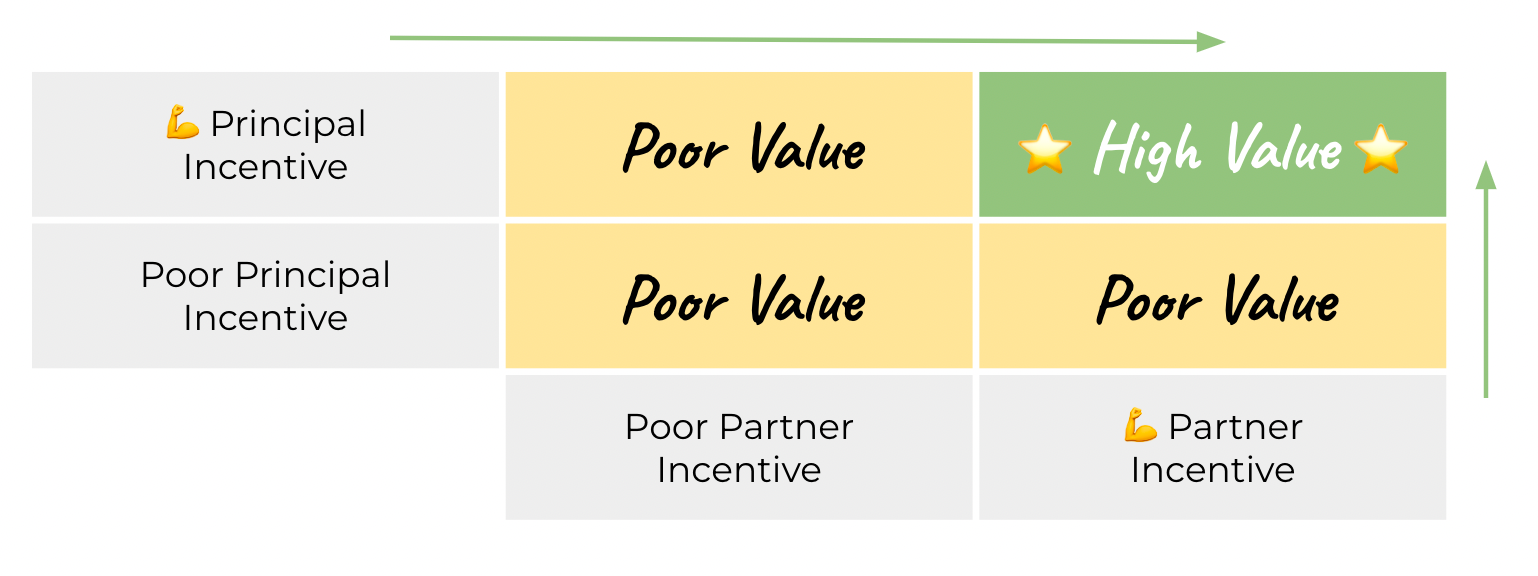Solving Principal Agent Problems in Partnerships
The best partner managers understand and pre-empt the principal agent problem when working with partners. They understand how stakeholders are incentivised across the jobs to be done and design programs such that incentives aligned and high.

Summary
The principal agent problem describes how conflicts of priorities can occur when parties are misaligned in their incentives.
The best partner managers understand and pre-empt the principal agent problem when working with partners. They understand how stakeholders are incentivised across the jobs to be done and design programs such that incentives aligned and high.
Here's what we cover
What is the Principal Agent Problem?
I first came across the term principal agent problem in an a16z podcast and it was a revelation.
Here's what it means according to Investopedia.
The principal-agent problem is a conflict in priorities between a person [...] and the representative authorised to act on their behalf. An agent may act in a way that is contrary to the best interests of the principal.
Let's translate this into business speak:
- If you (principal) and your agent are misaligned on incentives, then things will likely be shitty 💩
- On the other hand, if your incentives align then you’ve “resolved” the principal agent problem and things will be a-mazing 🌈
The principal agent problem manifests whenever there are two or more parties working in tandem towards a common goal. This includes when compensating sales people, in business partnerships, in DeFi protocols (3,3 anyone?), etc.
Your goal? Resolving the principal agent problem by creating incentives for the agent to act as you want them to.
The Principal Agent Problem Applied to Partnerships
Now, let's apply this to channel partnerships where you (principal) work with partners (agents) to go-to-market.
Here are some ways the principal agent problem may come about:
- The partner feels insufficiently compensated for their time, and chooses to recommend competing products
- The partner is insufficiently trained, and mis-sells to customers
In each of these cases, there is a principal agent problem that needs to be resolved, otherwise the partnership will not work.
What's clear is that partner programs with strong principal-agent alignment scale faster and bring about happy partners.
"Well, no shit."
No shit, indeed. But it's still helpful to use this concept to deconstruct and understand partnership structures or diagnose why a partnership may not be working.

I've used the principle agent problem concept to develop frameworks around complex partnerships that I think most partner managers can benefit from, specifically partnerships where:
- There are multiple jobs to be done
- There are multiple stakeholders
Now, let's get into the fun stuff.
Partnerships with Multiple Jobs to Be Done
When working with a partner, there are multiple jobs to be done. Each one of these "jobs" represents a potential principal agent problem.
For example, if you expect your partners to sell your product, onboard customers, and then support these customers, these are 3 "jobs to be done". In this case, you need to ensure that you resolve the principal agent problem for each one of the "jobs".
A simple exercise that you can conduct is to:
- Map out the jobs to be done with your partner
- Ensure that the partner is sufficiently incentivised and aligned for each job
- If they are not, consider redesigning your partner programs incentives around the key jobs to be done
Partnerships with Multiple Stakeholders
Let's add more stakeholders into the mix. In most partner deals you'll see the following stakeholders:
- 📱 - Your business
- 💁♂️ - Your sales team
- 👔 - Partner's business
- 🙋 - Partner's sales rep, an
- 🦸 - The customer
What does a win-win (or win-win-win-win-win 😅) look like here?
Let's call the chain of stakeholders in which decisions are made the "value chain". Essentially, for the deal to be successful each stakeholder needs to see sufficient value (or incentive). If there's insufficient value for any stakeholder, either the deal will break down or that stakeholder has a poor experience.
To make more sound decisions when multiple stakeholders are involved, make sure that you understand:
- Who are the stakeholders in the value chain?
- What are the key motivations (or KPIs) for each stakeholder?
- What value or incentive needs to exist for each person for the current job to be done?
- What is the risk if a stakeholder in the value chain sees insufficient value or incentive?
A common error partner managers make is not factoring in all the stakeholders involved in a deal which can often lead to that deal's demise.
The Value Chain Framework for Analysing Partnerships
When you combine our learnings across job to be done and multiple stakeholders, you get a robust framework to analyse value creation in partnerships.
I've created the Value Chain Framework to help visualise partner incentives and that you can use to analyse your partner program.

Here are the steps in the framework:
- Add the major stakeholders in the value chain (A2:2 in the template)
- State the key motivations for each stakeholder (B2:2)
- List out the jobs to be done for your partner program (B3:B)
- List out your partner program mechanics for each job to be done (C3:C)
- Indicate how likely each stakeholder is to be incentivised with the current program structure (D3:3)
- For any misaligned stakeholder, consider ways to update the program structure or incentives to realign them (E3:3)
Even if you don't complete the full exercise, thinking through the first few steps of the framework can be immensely beneficial. By mapping out the stakeholders and their key motivations, you're aware of the problem set and possible gaps in the value chain.
As you complete each additional step, you'll get a better sense of how your partner program operates and where it might need to be iterated.
The Principal Agent Problem is Universal
The frameworks described above are easily transferable into other areas of business. As a general habit, be aware of the jobs to be done and stakeholders involved. This was you can ensure the right incentives are in place.
Ray Dalio in Principles alludes to this and suggests stepping back and "[looking] at the machine from a higher level". With a 100-foot view of the problem it's easier to see the cogs in the machine and find the right incentives for each one. To extend this analogy further, it's easier to grease the wheels than forcing things with a hammer.
Anticipating and pre-empting the principal agent problem can lead to better relationships, better outcomes, and happier stakeholders – all of which are essential to great partner programs and business in general.
Thanks for reading all this way! 🙌
Have I over-analysed the principal agent problem? Perhaps, but I've found the principal agent dynamic (and by extension the value chain framework) to be essential when building complex partnerships.
Furthermore, it's a neat teaching mnemonic in the partnership toolkit to educate the rest of the organisation on how (and why) we incentivise partners.
If you have questions or are curious to learn more, feel free to hit me up on LinkedIn or Twitter. 👋
You can also follow me or hit subscribe to keep in touch. I write regularly about growth, marketing, and partnerships in tech and fintech.

